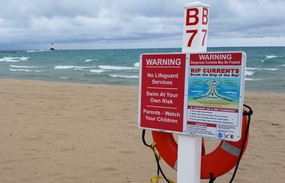
Celebrating
40 years of Michigan’s Coastal Management Program
The establishment of Michigan’s Coastal
Management Program through the National Oceanic and Atmospheric Administration
in 1978 elevated the importance of “the Freshwater Coast” to the national
scale, beginning the state’s now four decades of work to protect, enhance and
restore Michigan’s 3,288 miles of Great Lakes coastline.
The program’s five staff coordinators work as a
team of “coastal ambassadors” with the leadership of the program manager, each
addressing a facet of coastal stewardship: habitat, public access, water
quality, community development, and hazard management.
NOAA, the program’s federal partner, refers to “Coastal management,” as the actions taken to keep the
environmental, community and economic aspects of coastal life in balance. Here's a little more about how the coordinators do that:
A Coastal Habitat Coordinator works to protect our coast’s unique places
including freshwater wetlands, dunes and beaches, home to rare and endangered
species found nowhere else in the world.
|
 Public access to the Great Lakes is critical to the Michigan way of life. The Coastal Program’s Public Access Coordinator helps communities establish water trails, add beach access, protect historic resources (like lighthouses and shipwrecks), and construct accessible kayak launches. These projects enhance residents' and visitors' opportunities to swim, paddle, hunt for sea glass, and connect with nature in meaningful ways.
A Water Quality Coordinator tackles coastal issues by engaging residents in water stewardship through partner programs like Adopt-a-Beach and Michigan Clean Marina.
|
 This coordinator also works with communities to implement green infrastructure techniques that mimic nature’s processes, which helps communities become resilient to the effects of flooding, Great Lakes weather and changing water levels.
|
The Coastal Program also is involved in promoting community growth; a Community Development Coordinator supports planning for economically sustainable waterfront towns that are good places to live. This takes smart planning and an understanding of the Great Lakes assets that make coastal communities special.
Although we don’t experience hurricanes on the Great Lakes, they are dynamic systems that need to be respected. The Coastal Hazards Coordinator educates communities on coastal management techniques that can reduce risks from hazards like erosion, dangerous currents, flooding and storms – saving lives, homes, and infrastructure. |
|
 |
Since its inception, the Coastal Management Program has made strategic investments of millions of dollars in coastal communities and provided the technical assistance to get the work done.
In its 40th year, the coastal program team plans to focus on community resiliency, coastal dunes and education. The team will promote water stewardship in communities, continue work to establish and enhance water trails, and work in boating communities to keep marinas clean.
To call attention to Michigan’s amazing Great Lakes coastal resources and the work of the state’s Coastal Management Program, the Office of the Great Lakes has named 2018 “The Year of the Coast.” Follow our journey on Twitter with #YearoftheCoast2018 for coastal facts, information, projects and ways to get involved. Visit the program website at www.michigan.gov/coastalmanagement.
|